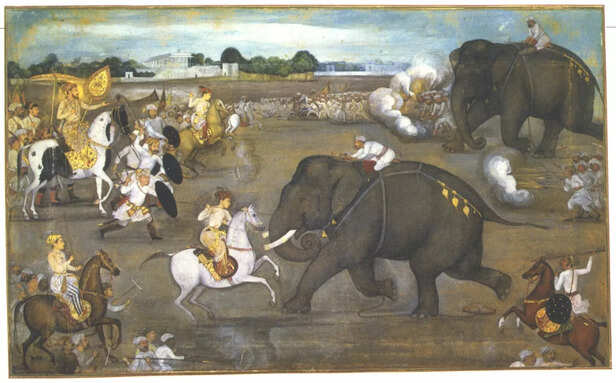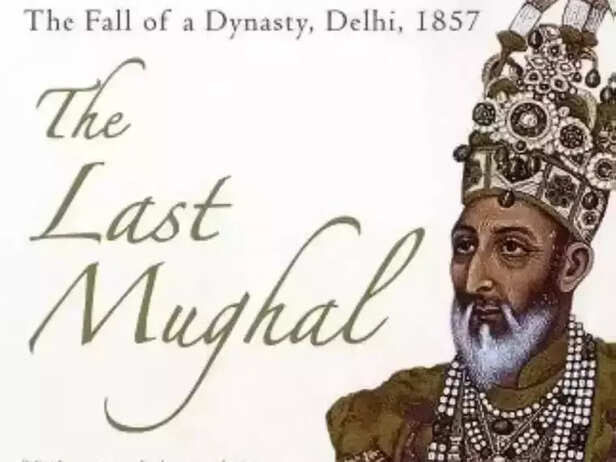Aurangzeb Wanted Shivaji’s Head—But Shivaji Took His Throne
Nidhi | Mar 11, 2025, 21:46 IST
( Image credit : Times Life Bureau )
Aurangzeb and Shivaji's rivalry wasn't just about land and power—it was a battle of ideologies and strategies. While Aurangzeb commanded a mighty empire, Shivaji's tactical brilliance and vision for Swarajya challenged the Mughal dominance. Discover how Shivaji's daring escapes, military strategies, and political foresight outsmarted Aurangzeb, leaving a legacy that outlived the Mughal empire.
What happens when two visions for a kingdom collide—one driven by religious orthodoxy, the other by the spirit of independence? The 17th-century conflict between Emperor Aurangzeb and Chhatrapati Shivaji Maharaj was not just a power struggle—it was a battle of ideologies, governance, and military strategy. Aurangzeb, the iron-fisted Mughal emperor, sought to impose Islamic dominance and centralize authority, while Shivaji, the fearless Maratha warrior, dreamed of Swarajya—self-rule rooted in Hindu traditions and decentralized power. Their clash reshaped Indian history, leaving a legacy that echoed far beyond their lifetimes.
 It’s almost poetic how two leaders, born under the same sky, could see the world so differently. Aurangzeb, born in 1618 to Emperor Shah Jahan, was groomed in the splendor of the Mughal court. He was a devout follower of Islam and believed that consolidating power under religious authority was the path to stability. Shivaji, born in 1630 at Shivneri Fort to Shahaji Bhonsle and Jijabai, was raised on the ideals of Hindu pride and self-rule. While Aurangzeb sought to build an empire through submission, Shivaji envisioned a kingdom where governance was rooted in cultural identity and local autonomy.
It’s almost poetic how two leaders, born under the same sky, could see the world so differently. Aurangzeb, born in 1618 to Emperor Shah Jahan, was groomed in the splendor of the Mughal court. He was a devout follower of Islam and believed that consolidating power under religious authority was the path to stability. Shivaji, born in 1630 at Shivneri Fort to Shahaji Bhonsle and Jijabai, was raised on the ideals of Hindu pride and self-rule. While Aurangzeb sought to build an empire through submission, Shivaji envisioned a kingdom where governance was rooted in cultural identity and local autonomy.
Their paths were destined to cross—not just as adversaries on the battlefield, but as symbols of two opposing ideologies.

The first spark of conflict ignited in 1657 when Shivaji’s forces began raiding Mughal territories near Ahmednagar and Junnar. Aurangzeb, then the governor of the Deccan, ordered immediate retaliation. But Shivaji wasn’t playing by the Mughal rulebook. He mastered the art of guerrilla warfare—swift cavalry attacks, strategic ambushes, and surprise retreats. His knowledge of the rugged Deccan terrain gave him an advantage that even the mighty Mughal armies couldn’t match.
This wasn’t just rebellion—it was psychological warfare. Shivaji struck where the empire was most vulnerable, undermining Aurangzeb’s sense of control.
 In 1664, Shivaji launched one of his boldest moves—an attack on Surat, the Mughal Empire’s key port city and a major trade hub. His forces plundered the city’s wealth, crippling the Mughal treasury and sending a clear message to Aurangzeb: Shivaji was no regional bandit—he was a king in the making.
In 1664, Shivaji launched one of his boldest moves—an attack on Surat, the Mughal Empire’s key port city and a major trade hub. His forces plundered the city’s wealth, crippling the Mughal treasury and sending a clear message to Aurangzeb: Shivaji was no regional bandit—he was a king in the making.
Aurangzeb’s response was swift and brutal. He dispatched Mirza Raja Jai Singh with a formidable army to crush Shivaji’s rebellion. Shivaji, outnumbered and facing tactical defeat, agreed to the Treaty of Purandar in 1665, surrendering 23 forts to the Mughals. It seemed like a setback—but Shivaji was playing a longer game.

In 1666, Shivaji was invited to the Mughal court in Agra—a rare honor for a regional leader. But honor quickly turned to humiliation. Aurangzeb deliberately placed Shivaji behind lesser nobles, an insult Shivaji could not ignore. When he protested, he was placed under house arrest—a thinly veiled death sentence.
But Shivaji had no intention of being a pawn in Aurangzeb’s game. Feigning illness, he began sending out baskets of sweets and fruits to the court as offerings. Hidden beneath the fruits were Shivaji and his son, Sambhaji. Under the cover of night, they escaped from Agra, leaving behind a humiliated emperor.
Shivaji’s escape wasn’t just an act of defiance—it was a turning point. It shattered the myth of Mughal invincibility and elevated Shivaji’s status to that of a folk hero among his people.
 On June 6, 1674, Shivaji crowned himself Chhatrapati (supreme sovereign) at Raigad Fort. This wasn’t just a political statement—it was a cultural revival. Shivaji reinstated ancient Hindu traditions, established a Maratha administrative system, and positioned himself as the protector of Hindu dharma.
On June 6, 1674, Shivaji crowned himself Chhatrapati (supreme sovereign) at Raigad Fort. This wasn’t just a political statement—it was a cultural revival. Shivaji reinstated ancient Hindu traditions, established a Maratha administrative system, and positioned himself as the protector of Hindu dharma.
Shivaji’s administrative reforms were revolutionary. He created the Ashta Pradhan (Council of Eight Ministers), introduced a fair taxation system, and built a naval fleet to protect the Konkan coast from Portuguese and British incursions. His governance combined military strength with economic foresight—something the Mughal empire, with its bloated bureaucracy and over-reliance on conquest, was beginning to lack.
Aurangzeb’s Southern Gamble: A Costly Mistake
By the 1680s, Aurangzeb grew restless. The Maratha resurgence was not just a military threat—it was an ideological one. In 1681, Aurangzeb personally led his armies into the Deccan to crush the Maratha rebellion. He succeeded in capturing Bijapur and Golconda, but his Deccan campaign quickly turned into a quagmire.
Shivaji’s death in 1680 left the Maratha Empire in the hands of his son, Sambhaji. In 1689, Aurangzeb’s forces captured Sambhaji. He was tortured and executed for refusing to convert to Islam—a move that Aurangzeb believed would crush Maratha resistance.
Instead, it had the opposite effect. The Marathas rallied behind Shivaji’s legacy, launching a guerrilla campaign that bled the Mughal treasury and stretched the empire’s resources thin. The Marathas turned the Deccan into a battlefield where no Mughal army could hold ground for long.

Aurangzeb died in 1707, exhausted and disillusioned. His three-decade-long Deccan campaign had drained the Mughal Empire of its wealth and military strength. Without a clear successor, the empire fragmented under the weight of internal conflicts.
Meanwhile, the Marathas emerged as the dominant power in India. Shivaji’s legacy of decentralized governance and military resilience became the foundation for the Maratha Empire, which would dominate Indian politics in the 18th century.
The conflict between Aurangzeb and Shivaji was not just about territory—it was about the future of Indian governance. Aurangzeb’s attempt to impose religious orthodoxy and centralized power ultimately weakened the Mughal Empire from within. Shivaji’s vision of Swarajya—a blend of military strength, cultural revival, and decentralized governance—outlived both him and his empire.
Aurangzeb may have held the larger army, but Shivaji wielded something more enduring—a vision rooted in the spirit of the land and the hearts of the people. History proved that while empires rise and fall, the idea of Swarajya—the right to self-governance—stands the test of time.
Two Men, Two Destinies

Aurangzeb
( Image credit : Times Life Bureau )
Their paths were destined to cross—not just as adversaries on the battlefield, but as symbols of two opposing ideologies.
A Slow Burn of Conflict

Aurangzeb faces Sudhakar
( Image credit : Times Life Bureau )
Raids and Retaliation: The Seeds of War
This wasn’t just rebellion—it was psychological warfare. Shivaji struck where the empire was most vulnerable, undermining Aurangzeb’s sense of control.
The Siege of Surat: A Direct Challenge to Aurangzeb’s Authority

Shivaji Maharaj
( Image credit : Times Life Bureau )
Aurangzeb’s response was swift and brutal. He dispatched Mirza Raja Jai Singh with a formidable army to crush Shivaji’s rebellion. Shivaji, outnumbered and facing tactical defeat, agreed to the Treaty of Purandar in 1665, surrendering 23 forts to the Mughals. It seemed like a setback—but Shivaji was playing a longer game.
The Agra Incident: A Masterstroke in Strategy

Aurangzeb: Mughal emperor
( Image credit : Times Life Bureau )
A Royal Invitation or a Trap?
But Shivaji had no intention of being a pawn in Aurangzeb’s game. Feigning illness, he began sending out baskets of sweets and fruits to the court as offerings. Hidden beneath the fruits were Shivaji and his son, Sambhaji. Under the cover of night, they escaped from Agra, leaving behind a humiliated emperor.
Shivaji’s escape wasn’t just an act of defiance—it was a turning point. It shattered the myth of Mughal invincibility and elevated Shivaji’s status to that of a folk hero among his people.
Shivaji’s Coronation: The Birth of Swarajya

Shivaji Coronation
( Image credit : Times Life Bureau )
From Warrior to King
Shivaji’s administrative reforms were revolutionary. He created the Ashta Pradhan (Council of Eight Ministers), introduced a fair taxation system, and built a naval fleet to protect the Konkan coast from Portuguese and British incursions. His governance combined military strength with economic foresight—something the Mughal empire, with its bloated bureaucracy and over-reliance on conquest, was beginning to lack.
Aurangzeb’s Southern Gamble: A Costly Mistake
An Empire Stretched Too Thin
Shivaji’s death in 1680 left the Maratha Empire in the hands of his son, Sambhaji. In 1689, Aurangzeb’s forces captured Sambhaji. He was tortured and executed for refusing to convert to Islam—a move that Aurangzeb believed would crush Maratha resistance.
Instead, it had the opposite effect. The Marathas rallied behind Shivaji’s legacy, launching a guerrilla campaign that bled the Mughal treasury and stretched the empire’s resources thin. The Marathas turned the Deccan into a battlefield where no Mughal army could hold ground for long.
The Fall of the Mughal Empire and the Rise of the Marathas

Decline of Mughal Era
( Image credit : Times Life Bureau )
Aurangzeb’s Death and the Shifting Tide
Meanwhile, the Marathas emerged as the dominant power in India. Shivaji’s legacy of decentralized governance and military resilience became the foundation for the Maratha Empire, which would dominate Indian politics in the 18th century.
The Clash That Redefined Indian History
Aurangzeb may have held the larger army, but Shivaji wielded something more enduring—a vision rooted in the spirit of the land and the hearts of the people. History proved that while empires rise and fall, the idea of Swarajya—the right to self-governance—stands the test of time.
